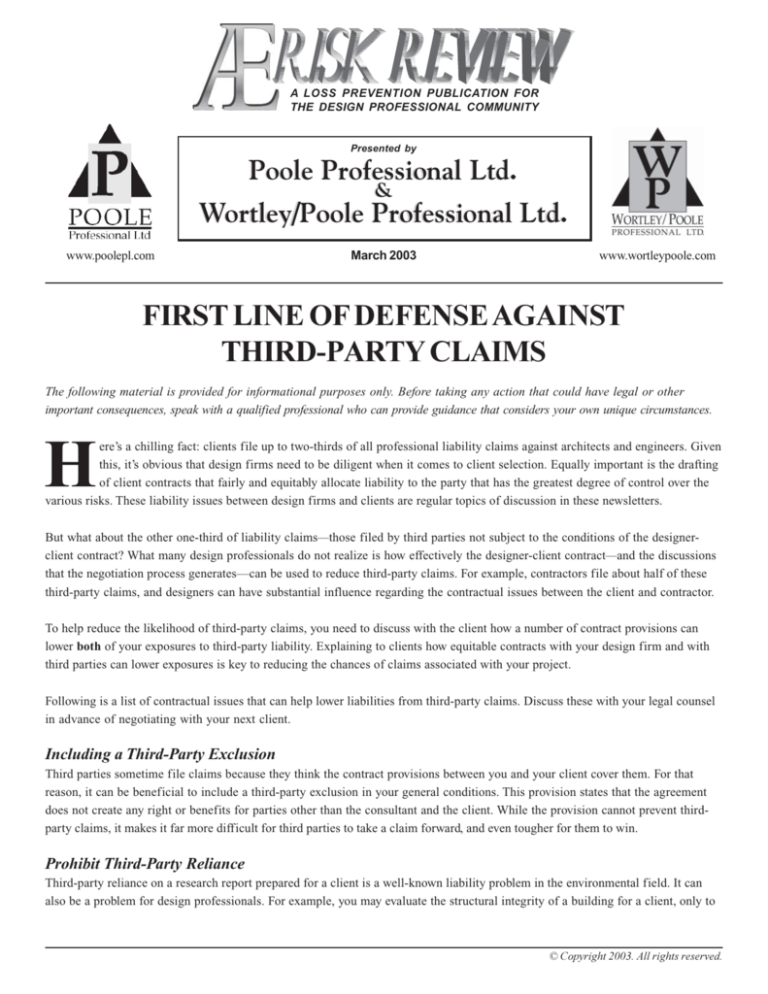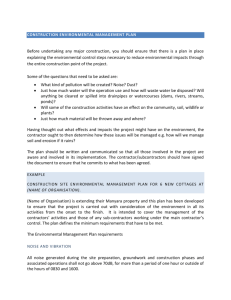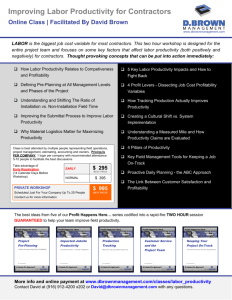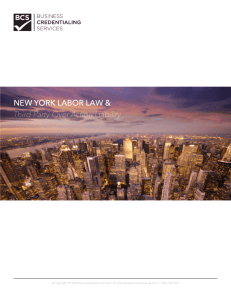
A LOSS PREVENTION PUBLICATION FOR
THE DESIGN PROFESSIONAL COMMUNITY
Presented by
Poole Professional Ltd.
&
Wortley/Poole Professional Ltd.
www.poolepl.com
March 2003
www.wortleypoole.com
FIRST LINE OF DEFENSE AGAINST
THIRD-PARTY CLAIMS
The following material is provided for informational purposes only. Before taking any action that could have legal or other
important consequences, speak with a qualified professional who can provide guidance that considers your own unique circumstances.
H
ere’s a chilling fact: clients file up to two-thirds of all professional liability claims against architects and engineers. Given
this, it’s obvious that design firms need to be diligent when it comes to client selection. Equally important is the drafting
of client contracts that fairly and equitably allocate liability to the party that has the greatest degree of control over the
various risks. These liability issues between design firms and clients are regular topics of discussion in these newsletters.
But what about the other one-third of liability claims—those filed by third parties not subject to the conditions of the designerclient contract? What many design professionals do not realize is how effectively the designer-client contract—and the discussions
that the negotiation process generates—can be used to reduce third-party claims. For example, contractors file about half of these
third-party claims, and designers can have substantial influence regarding the contractual issues between the client and contractor.
To help reduce the likelihood of third-party claims, you need to discuss with the client how a number of contract provisions can
lower both of your exposures to third-party liability. Explaining to clients how equitable contracts with your design firm and with
third parties can lower exposures is key to reducing the chances of claims associated with your project.
Following is a list of contractual issues that can help lower liabilities from third-party claims. Discuss these with your legal counsel
in advance of negotiating with your next client.
Including a Third-Party Exclusion
Third parties sometime file claims because they think the contract provisions between you and your client cover them. For that
reason, it can be beneficial to include a third-party exclusion in your general conditions. This provision states that the agreement
does not create any right or benefits for parties other than the consultant and the client. While the provision cannot prevent thirdparty claims, it makes it far more difficult for third parties to take a claim forward, and even tougher for them to win.
Prohibit Third-Party Reliance
Third-party reliance on a research report prepared for a client is a well-known liability problem in the environmental field. It can
also be a problem for design professionals. For example, you may evaluate the structural integrity of a building for a client, only to
© Copyright 2003. All rights reserved.
have the client sell the property, using your report as part of the sales proposal. For that reason, your client contract should include a
third-party-reliance provision that forbids any party other than the client to rely on your report, unless you give explicit permission
for it to do so. Wording about third-party reliance should be included in any report you develop for a client.
To reduce your risk further, include a copy of your contract with your client as an appendix to any research report you produce. This
will indicate specifically the scope of services you were hired to provide and the nature of the agreement between your firm and the
client for whom the service was performed. Any limitations as to your liability for your work that are included in the client contract
(such as the third-party-reliance provision) will then be made known to the third parties.
Watch Out For Contractor Claims
Third-party claims brought against design consultants and their clients are frequently filed by contractors or other parties damaged
by contractor error. You can help prevent claims of this nature by offering a variety of services as part of your scope of services.
For example:
•
Contractor pre-qualification helps ensure that the selected contractor has the experience and credentials required to perform the
required services. That alone can help prevent problems. Moreover, should a problem arise, a reputable contractor will be more
likely to seek a quick and equitable resolution. Contractors that obtain work on an open bidding basis are sometimes unfamiliar
with local conditions or the full scope of services that may be required, or they may be buying into a contract in hopes of
making a profit through change orders and/or negligence claims.
•
Pre-bid meetings can help ensure contractors’ questions are answered before work begins. You are in the best position to answer
questions about your portion of the work.
•
Pre-construction meetings can further contribute to clear understanding between the contractors and design professionals
involved in the project.
•
Construction observation services are essential to minimizing problems. The designer can spot problems that contractors,
subcontractors and other third parties do not see and can deal with them at the “molehill stage.” The documentation that results
can also help discourage a contractor from filing a suit for damages due to design firm negligence or omissions. If an owner
refuses your construction observation services, work with legal counsel to obtain contractual protection for claims that arise
due to the lack of coordination or the lack of professional interpretation of the construction documents during the
construction phase.
•
You should call for the owner’s agreement with the contractor to include a provision requiring the contractor to hold you and
the owner harmless for jobsite safety issues. The same provision could call for the contractor to make you and the owner
additional insureds on the contractor’s general liability insurance.
Shop Drawing Review
In many states, third parties cannot successfully file a negligence claim when the losses are purely monetary, e.g., as a consequence
of delays. In other states, where third parties can sue for purely monetary losses, delay claims by contractors are becoming more common.
A typical method used by unscrupulous contractors is to inundate design consultants with shop drawings, causing a sharp slowdown
in the review process. Other problems can arise when shop drawings differ significantly from what was originally called for—but
such differences are not called to your attention.
© Copyright 2003. All rights reserved.
2
You can use a contract provision to bring this problem to your client’s attention, thus gaining client support in developing effective
shop drawing review procedures. In essence, you identify which shop drawings you want to see, requiring the contractor to review
and approve each drawing before you see it and to call to your attention any that would represent a design change. By adhering to
these requirements, you can help prevent shop drawing review from becoming a profit center for those who intend to misuse the process.
Diminution of Value
Diminution of value can be a serious problem relative to conditions surveys of any type. When your client is considering the
subject property for purchase, your finding of a latent problem would cause the property to lose value or delay the transaction.
When you seek protection for this third-party exposure in your contract, typically through an indemnification provided by your
client, you can bring the issue to the surface. Your client can then seek protection from the property owner, requiring the latter to
agree to waive any claim brought about by a finding that makes a property less valuable.
Right of Entry
When it comes to conditions surveys or forensic work, you need to ensure you have a legal right to enter onto property not owned
by your client. Otherwise, you could be faced with trespassing charges or worse, such as a claim that your forensic evidence was
gained through unlawful means. Be certain that the necessary permission is obtained, and that (when appropriate) the property
owner is advised that the work you do may involve some property damage. The client should be responsible for this activity.
Certifications
Various documents, such as those required by lenders, may require design professionals to certify that certain conditions have been
met. It is impossible to certify conditions as fact, but a design professional can give an opinion regarding conditions, e.g., that a
building was constructed in compliance with drawings, specifications, and applicable codes and standards.
The word “certify” can easily be taken to mean guarantee, and to guarantee the existence of conditions whose existence cannot be
verified is foolhardy. Making it even more dangerous is the fact that most professional liability insurance policies today do not
cover any losses resulting from such guarantees. Your client should care about certifications you are required to make because, if
you lose your coverage, the claimant will likely come after the client—the party that caused you to sign a document that resulted in
your loss of insurance. By calling the issue to the client’s attention by means of a contract provision, you can encourage the client
to explain the situation to third parties who seek certification.
Site Safety
Claims filed against you by injured contractors’ employees are among the most common of those not filed by clients or contractors.
They arise because design professionals are among the few parties available to sue, given that 1) under workers’ compensation laws,
employees generally cannot sue their employer for workplace accidents, and 2) owners typically have nothing to do with what
happens at a site.
In order to forestall such site safety suits—and to permit you to reduce or eliminate any contingency allowance you might require in
contemplation of the risk—the client needs to make it clear in your agreement that you are not responsible for site safety, or the
means, methods, sequences and operations of construction. These functions are vested solely in the contractor or, where applicable,
the construction manager. In those states where design professionals are protected by workers’ compensation “wrap-up” provisions,
having such contract language is essential to obtain the protection.
Beware Condominium Conversions
Generally, only the owner of an apartment building you designed would be in a position to instigate a claim on the ground that an
error or omission on your part led to an unanticipated expense. By contrast, each and every owner of a condominium unit could file
such a claim against you, and—generally speaking—unit owners are far more sensitive to construction defects, far quicker to rely on
3
© Copyright 2003. All rights reserved.
litigation, and in a far better position to win at trial. In fact, condominiums are among the riskiest projects a design firm can get
involved with, in terms of both claim frequency and severity.
While conventional contract protections, such as limitation of liability provisions, remain appropriate in your contract with the
owner/developer of an apartment project, recognize that unit owners—not your client—would be the most likely claimants if that
apartment building were converted to condominium ownership. Accordingly, if you are engaged to provide services on an apartment
project, consider including a condominium conversion clause, that states that your client does not foresee conversion of the
building to condominium ownership. (Generally, you are liable only to those parties who might foreseeably be damaged by your
negligent acts, errors or omissions.)
Condominium developers also are at risk of lawsuits filed by unit owners who face unanticipated costs. In many cases these costs
occur not because of inadequate design or construction, but because the condominium managers have not effectively maintained
the building and its equipment. You can therefore help your client by including a provision in your agreement requiring the client
to include a maintenance requirement in the condominium’s bylaws, causing the condominium owners to waive any claims against
the developer, consultants and contractors for failure of equipment or materials that are not properly maintained.
Client & Contractor Insurance Provisions
As we pointed out in an earlier issue, the risks of claims increase to you and your client if the contractor —and construction
manager — do not have the requisite insurance and indemnity provisions. Be diligent about making sure the owner properly
incorporates the necessary wording!
Can We Be of Assistance?
We may be able to help you by providing referrals to consultants, and by providing guidance relative to insurance issues, and even
to certain preventives, from construction observation through the development and application of sound human resources
management policies and procedures. Please call on us for assistance. We’re a member of the Professional Liability Agents Network
(PLAN). We’re here to help.
FOR MORE INFORMATION, CONTACT:
Poole Professional Ltd.
401 Edgewater Place, Suite 180
Wakefield, MA 01880
Wortley/Poole Professional Ltd.
100 No. 17th St., Suite 1200
Philadelphia, PA 19103-2703
Tel: 781 245-5400
Fax: 781 245-5463
cpoole@poolepl.com
tmullard@poolepl.com
Tel: 215 564-6970
Fax: 215 564-6975
kwortley@wortleypoole.com
© Copyright 2003. All rights reserved.
4








